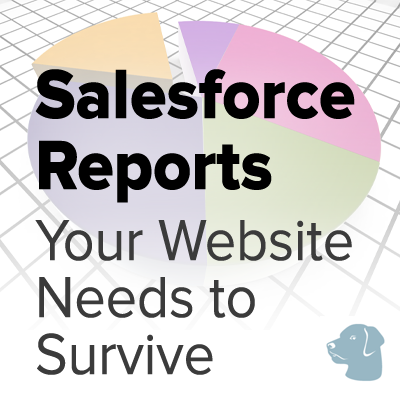Salesforce Reports Your Website Needs to Survive
In order for your website and internet marketing campaigns to be successful
New website projects should stem from the need to grow revenue and profits. But the perception from too many company executives is that the website is a cost. The reason this is happening is because CEOs and CMOs are typically frustrated by the fact that they can’t tie sales numbers to your website or internet marketing.
Website Metrics that Make Sense
Today, websites are smarter than ever. Between automated work flow rules, personalized content, marketing automation, A/B Testing and so forth, there is a great opportunity for a website to attract, convert and retain a lead for your company. For many years website marketers could really only utilize Google Analytics to gather website reports. By utilizing cloud-based solutions such as Salesforce.com, website marketers are able to redefine their impact to the bottom line. Websites are not only a lead generating tool anymore but also a digital sales person who is responsible for a quota each month, quarter and year.
Salesforce Reports You Should Create
- Total Amount of Closed Business from Website: It shows the aggregate impact on company revenue from the website or inbound marketing.
- Lead Quantity/Lead Quality Ratio: It might help your ego to report the number of leads your website received but if those leads are not converting deep into your sales funnel then you’re fishing in the wrong area. It’s important for website marketers to show the quantity of leads coming in through the website in addition to showing the number of those leads that converted into a true opportunity in your sales funnel. By dividing these numbers together you now have better insights into your conversion ratio. You are then able to make adjustments to your website strategy based on this ratio.
- Win-Ratio from Website Leads: It’s one thing to be able to measure the quality of the leads and whether they are flowing into your sales funnel but at the end of the day it’s the revenue that everyone wants to know. Creating a report of your company’s win-ratio from website generate leads will provide you with even better metrics. For example, if your company brought in $10 million in new opportunities from your website into the pipeline and you were able to close $2 million in new business then you know that your website win-ratio is 20%. Going forward as you plan out your next investment for your website strategy with a goal of increasing website revenue to $3.2 million you now can project that your website will need to bring in $16 million in new leads into the sales funnel.
- Indirect Impact: Very often your website is not the first impression your prospect may have with your company. It could very well be from a trade show, sales person, advertisement or anything else that is “offline”. Although you can’t measure indirect impact we believe the website does play a critical role in a prospect qualifying a company after the initial contact. For example, your sales person may meet a prospect at a networking event. In return, that prospect will perform research on your company website, create interest and call the sales person for a meeting. Then within a few weeks a contract is signed. We feel the website had an indirect impact on that sale. When tracking closed business from your “offline” marketing campaigns you might want to take anywhere from 3% – 5% of that number and attribute it to your website. This will be the “foggiest” number you will report on but it still requires attention.
It’s not easy to maneuver through all the numbers you need to collect but if you are not measuring your marketing then you will have an uphill battle in obtaining confidence from the executive level on the success of your website. These reports are not difficult to create in Salesforce but their value will bring answers to questions executives have been asking for so long.
What Salesforce reports do you feel work best to track or report your website’s goals? Leave a comment or contact us online to discuss this further.











